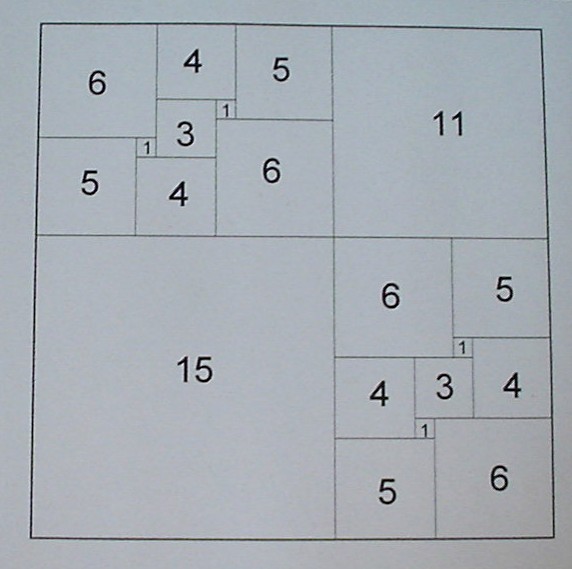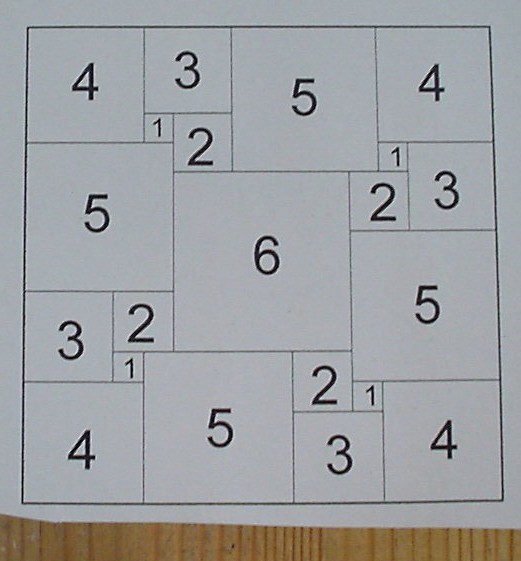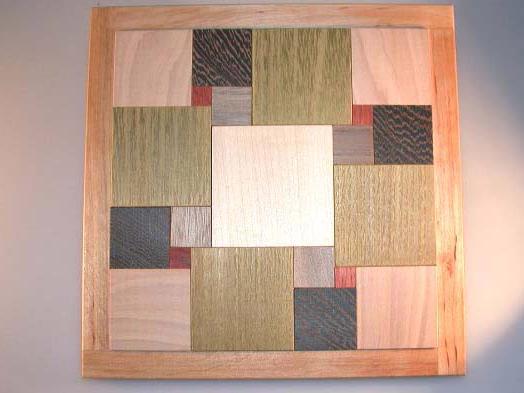A tiling of a big square by at least two smaller squares is called alternating, when there are no two neighboring squares of the same size. In his nice book "New Mosaics", published in 1997, Dr. Karl Scherer claims that the following example (designed by himself) has minimum number (= 20) of small squares.

Karl Scherer presents another beautiful solution with 21 little squares: here each side length from 1 to 5 occurs exactly in four squares, and length 6 occurs once, in the center.

Seeing this 21-solution I fell in love with it immediately. You can buy a nice wooden version in a web shop. Unfortunately, at that place Karl Scherer is not mentioned as the designer (although I mailed this information). Shame on the shop man!

"EinStein würfelt nicht" (Ewn) is my bestknown 2-person
game. The most complicated moment in the process
of production is when the numbers come on the stones.
Scherer's 21-tiling allows to play Ewn without numbers
on the stones:
When you role some number t, you have to move a stone
that is currently placed on a square of size t. When
you do not own such a stone you have to move the largest
possible smaller number or the smallest possible larger
number.
The Rules for Two Players
Each player has four stones in the beginning, placed in his
home corner, on the little squares of size 1, 3, 4, 5.
Red starts in the north-west corner, Blue starts in the
south-east corner. Red is winner when one of his stones
reaches the square in the south-east corner of the board.
Analogously, Blue is winner when one of his stones
reaches the square in the north-west corner of the board.
The players move in turn. Red is to start, or the player
who lost the previous game. A move consists two parts:
rolling the 6-sided die, and moving an "admissible" stone.
When you role some number t, you have to move a stone
that is currently placed on a square of size t. When
you do not own such a stone you have to move the largest
possible number smaller than t or the smallest possible
number larger than t.
Example for the starting position:
of a single
forward step of an own stone. When there is some other stone
on the target square of the move this stone is taken off
the board. This happens also if this stone belongs to the
player himself.
Forward directions
for Red are to the East and to the South. Forward
directions for Blue are to the North and to the West. There
are not diagonal steps, due to the "special" structure of
the board.
In case of four players two teams are formed.
The team partners start in opposing corners. A team has
won when one player reaches the opposing corner with one
of his stones. In contrast to the classical "Ewn quattro"
a team has not lost when one member is reduced to zero
stones. Instead, this player simply passes when it is his
turn.
In honour of Karl Scherer I named this game Scherer's Race.